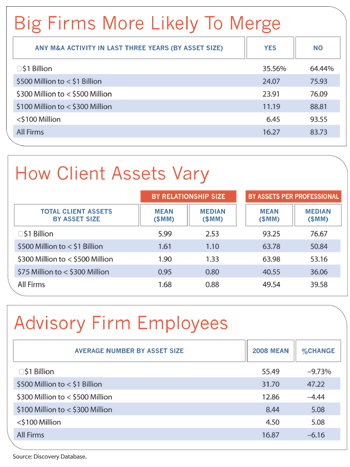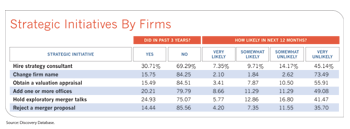It's hardly a surprise that amid the carnage in the stock market following the credit crisis last year, independent advisory firms took it on the chin in 2008, seeing their assets under management and revenues creamed. After posting large asset growth in 2007, RIAs participating in Financial Advisor's fourth annual RIA Survey saw discretionary and nondiscretionary assets together plummet by 13% in 2008. Of the 380 advisors who participated in the survey, 310 saw assets under management decline last year; 43% of the firms saw assets decline by 20% or more, 11% by 30% or more and 2% of firms saw their assets dip by more than 40%.
Such numbers were easily anticipated in a year when the S&P 500 index lost 38%. But the good news is that the great migration of clients to this space continues and far more firms picked up new relationships than lost them. Despite the understandable abdication of a few nervous Nelly customers, almost 80% of the firms who responded to the survey reported a net gain in new relationships in 2008. The median number grew to 243.0, or by 13%, from 215. This outpaces the growth of more than 10% reported in the 2007 survey, though it still trails the 17.32% new-client acquisition reported in 2006's poll.
The numbers are a reflection of what many advisors on Main Street could have told you already: Clients are moving away from brokerages and wirehouses, as many of their former advisors hide under rocks and refuse to answer the phones to address all the bad news. That's a big opportunity for advisors who are willing to work the phones, send out e-mails to their clients and otherwise ramp up their communications efforts.
"I think we're really seeing a change in 2008 and now into 2009," says Scott Houser, a vice president and principal at Ronald Blue & Co. in Atlanta. "Our clients are not just looking to their investment portfolios and measuring the growth rate, [and saying] 'Well if I get an 8% to 10% growth rate, all my financial needs are going to be met.' They are now taking a broader look at their finances and are looking at a comprehensive financial plan, and that's why our financial planning business has been growing. They're looking at things like not just accumulating net worth but looking at paying off debt, saving for college education, putting their money in buckets and getting a little bit more targeted approach."
Still, with assets levels sheared, account sizes have shrunk and profits have eroded, and many firms have had to lop off staff to deal with the income crisis. The median number of employees fell 11.1% to eight last year. This has meant an increased workload for those who stay behind; advisors are working harder for less pay and they're being stretched thin bringing new clients on board. And though a lot of clients and money are in motion, many more clients are still frozen and keeping their money sidelined in cash, another handicap since a cash-choked account doesn't yield much profit for financial advisors.
"People have less money to invest," says Brent Brodeski, managing partner with Savant Capital Management in Rockford, Ill., which saw its assets fall last year even though its client rolls increased by 136. "While we continue to bring clients over," he says, "the size of the dollars that they're bringing over is just inevitably smaller than it was."
According to this year's RIA survey, the size of the average client relationship fell 23.7% during 2008 to $1.67 million. Results in last year's survey showed the size of the average relationship growing 6.58% during 2007. Brodeski says Savant has kept a "war chest" of accumulated profits and used its technology to lower costs, and so far that means his firm has been able to avoid layoffs and has remained profitable, if not as profitable as it was before.
Big Growers
Among the fastest-growing advisors with $1 billion or more in assets in the 2008 survey were United Capital Financial Advisers in Newport Beach, Calif.; Mariner Wealth Advisors in Leawood, Kan.; GenSpring Family Offices in Palm Beach Gardens, Fla.; and Heck Capital Advisors LLC in Rhinelander, Wis.
Heck saw asset growth of more than 16%. Chairman Kenneth R. Heck, the company's chief financial officer and senior director of portfolio management, says that much of his firm's rapid growth came from an aggressive expansion (and a lot of 18-hour days) of pursuing nondiscretionary consulting assets to 401(k) and retirement plans, foundations, corporations and high-net-worth family offices after the firm's principals left their wirehouse relationship in May 2007. The good relationships have meant these clients have plowed money into the firm's direct investing accounts as well.
But just as good as the firm's offense was its defense, says Heck, in that it had a strong bond portfolio. "We probably had half or 50-50 on the discretionary side and our fixed income performed really well last year," he explains. "We do a lot of business on the municipal side, governments and corporates-and as the marketplace was seeing a downturn, we actually did well in those areas. We held high quality obligation bonds, and those areas did not take the hits that a lot of other bonds did."
"We know a lot of firms have grown [through mergers]" says Heck, "but we don't grow that way. It's always been a referral base."
Another firm that grew in clients and assets was RSM McGladrey Inc. in Minneapolis, which, like Ronald Blue, also reaped the fruit of new clients, in large part because of its connection with a large accounting arm. Many of these new clients were leaving the wirehouse channel, says Robert Eichten, director of financial planning and practice development at the firm.
"Many of the clients that we did acquire had prior advisory relationships, many of which were with wirehouse brokers," says Eichten. "The reason why we acquired them more than anything is because of the other accounting services we provide-the tax services, consulting services and things like that. And [the clients] got caught in a transaction or something. Many times it had something to do with taxes. Our wealth management is joined at the hip with the tax people and so we're able to be side-by-side, complementing and supplementing each other."
Companies such as United Capital and GenSpring, on the other hand, have continued to grow by aggressive consolidation. United Capital, a strategic buyer whose raison d'etre is to aggressively snatch up new firms for its network in hopes of an eventual big payday, signed definitive agreements for 12 deals in 2008. Some of the largest were Hotchkiss Associates, an RIA firm in Chicago; Trevethan Capital Partners, a lift-out from Oppenheimer & Co. in San Francisco; and The Hunter Group, an RIA in La Jolla, Calif.
GenSpring, meanwhile, picked up two firms early last year: Inlign Wealth Management in Phoenix with nearly $2 billion in assets under advisement and TBK Family Office in Miami with more than $1.5 billion in assets. (GenSpring has already picked up two more firms since 2009 began.) Though the market downturn buffeted those new assets later, the company still saw a net $2.4 billion in asset growth and 200 new client relationships. The firm caters to high-net-worth individuals, and the average AUM per client was about $20 million, according to the survey. One reason for the growth outside of the acquisitions, says senior partner John Elmes, is that many of the firm's existing clients have moved assets they'd parked with other companies in the past.
"One of the things we saw last year," says Elmes, "was many families consolidated their assets with us. Let's say they had a liquidity event and had $20 million with us and $20 million with Goldman Sachs. We did see a lot of consolidation where people put assets with us that had been split up. Having one advisor who was sitting on their side of the table made more sense. As the tide goes out, the families really see who is helping them and that's a huge boost for any firm, not just GenSpring."
The devastation in the market and the difficulty some firms have controlling costs will likely make some of them potential acquisition or merger targets. But bigger firms are still more likely to merge. In the last three years, 35.56% of those firms with a billion or more in assets under management have seen merger activity, while only 24.07% of those firms with $500 million to a billion in assets had pursued such transactions. The number diminishes as the categories are winnowed down.
Savant, which reported assets of $1.19 billion for 2008, is considering acquisition opportunities for the first time, Brodeski says. He even says that smaller RIAs are coming to his large firm looking to be squired.
"Seems like if you go back two years ago, it was really more of a seller's market," he says. "There were very few practices for sale and in fact the few that were for sale were obscenely priced. All of a sudden it seems like, while there's not been a lot of transaction activity, it appears as if there's a lot more interest for RIAs to sell at this point because they're not making a lot of money and they may even be losing money."
GenSpring's Elmes agrees that many multifamily offices are feeling constrained by the market downturn, and as assets go down, they can benefit more from merging or being bought by a larger firm like his. "Multifamily offices today-their assets are declining but their expenses are staying the same unless they reduce their staff," Elmes says. "A lot of them had not. That means expenses as a percentage of assets have gone up and that helps us [pitch GenSpring as a buyer]. Our advantage is that we've created a resource center that allows them to create scale."
Mark Tibergien, CEO of Pershing Advisor Solutions, says merger activity among RIAs slowed in 2008. Though the firm did its last report in August, he says the M&A market continued to be sluggish through the first two months of 2009. Nobody wanted to buy beach property in a hurricane, he says.
"When the meltdown occurred in September things pretty well came to a halt, probably because capital was not available," he says. "Portfolio values dropped and consequently business values dropped. And the reason is that many buyers base the value on trailing-12-months revenue."
But he also says that after the first two months of 2009, the merger chatter started again. Tibergien says that the problems in 2008 have left some RIAs seeing weaknesses in their firms' structures and perhaps made them more amenable to the idea of merging with a larger firm, yielding to a bigger structure than can help them share overhead costs and create a bigger market presence.
"One of the things we've been finding through the course of our white papers is that the fastest-growing firms are the largest ones," he says. "Which is counterintuitive. You would think the fastest-growing firms would be the smaller ones. Because one would instinctively say that on a percentage basis, smaller firms would grow faster because the baseline is lower. But in reality the ones growing faster are the bigger firms because they have the physical capacity to grow."
There's another reason the biggest firms are growing at a faster rate. It's because they want to grow. That's why 35.6% of firms with more than $1 billion in assets said they had been involved in merger activity over the last three years, while only 11.2% of firms with between $100 million and $300 million had done so. Different size firms have different priorities.
Click here to view the full survey sponsored by 


